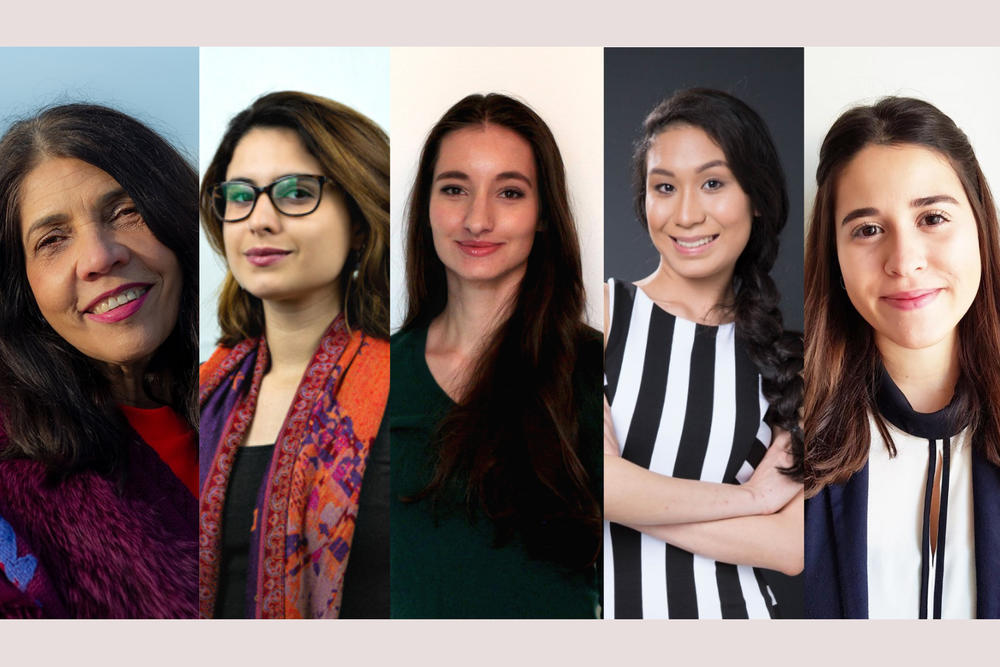A Museum Without Walls
Because everybody is a potential migrant: An alumna and a group of students from Freie Universität have founded a virtual Migration Museum
Jun 01, 2021
The DMM team (from left to right): Suely Torres, Anna Sara Dias Portugal Guimaraes, Laura Gröbner Ferreira, Fernanda Sumita, Mariana Florio
Image Credit: Personal collection
How does moving to another country change you? The digital German Migration Museum (DMM) offers a platform for migrants to reflect on this question, using video interviews to explore the diverse and complex ways in which migrants share in their new society. Suely Torres, who studied at Freie Universität Berlin, had the idea of setting up an online museum long before the coronavirus pandemic made virtual formats commonplace. Now, together with three students from the Institute for Latin American Studies (LAI) at Freie Universität Berlin, she has turned her idea into a reality. The museum went online in December 2020.
A young man in Berlin, standing in a huge green field in Tempelhof where planes once flew in and out of the city, is pointing at the old airport terminal. The building was adapted to provide living quarters for refugees in 2015, and after fleeing from Syria in 2016, Ibrahim Al-Hussein lived here for two years. His accommodation was a cabin, shared with seven others. “It was the waiting that really got me down,” he says. Will I be able to stay in Germany? Will I be allowed to study? When can I start looking for my own apartment?
Migrants Tell Their Stories in Their Own Words
This video of Ibrahim Al-Hussein can be viewed on the German Migration Museum website, an online platform where people talk about their own very personal experiences of migration, whether they have come to Germany as migrants, or left the country to move elsewhere. Through these personal narratives, we can see the diverse experiences that migrants bring with them, and how their creativity and hard work contribute in a variety of ways to the economy, society, and culture.
Luzia Simons, a Brazilian artist, for example, reflects on the meaning of her passport. The artist Henok Getachew from Ethiopia describes how his art has changed since he came to Berlin. Veso Portarsky is a Bulgarian writer who has found inspiration for his short stories in the German capital. Suely Torres, who had the original idea for the museum, explains, “The online museum is not so much about showing where migrants have come from and how they got here, but rather, what the process of migration itself does to people.”
Stories against Stereotypes
Suely Torres was born in Recife, Brazil. She came to Germany at the end of the 1980s and studied Latin American literatures and cultures, with a focus on Brazil, at Freie Universität Berlin. “I noticed very early on that stereotypes predominated when talking about migration, with a lot of focus on migrants being ‘different’ and ‘foreign’,” she says. She spent many years researching and working on the idea of a museum where migrants could tell their own stories from their multiple perspectives – the kind of place that at that time did not seem to exist anywhere in reality.
While working as a photographer and teaching Portuguese, she also continued to study curatorial practice at Berlin’s University of the Arts (UdK). She spent some time researching at the Museu da Pessoa in São Paulo – another online museum – learning how this kind of project could be implemented. During her studies at the UdK, she was also coached by Dr Susanne Rockweiler of the Gropius Bau museum in Berlin, who encouraged her to turn her idea into a reality.
The Ideal Site: The Internet
Together with three students from Freie Universität Berlin, Suely Torres registered the Migration Museum as a not-for-profit organization in 2017. The museum opened its doors online in December 2020.
Suely Torres decided that the first people she would interview for the museum would be people she knew personally. She interviewed, for example, Adriane Queiroz, an opera singer at the Berlin State Opera, and the Afro-German music historian and saxophone player Harald Kisiedu, who researched jazz as a global phenomenon at Columbia University, New York. Kisiedu is among the German interviewees who have left Germany to live elsewhere.
“We want to show that everyone is a potential migrant,” explains Mariana Florio, a master’s student at the LAI who joined the now five-strong team to translate and transcribe the videos into several languages. “The videos reveal so many different perspectives that my own understanding of migration is constantly being deconstructed and reconstructed,” says Florio.
Museum To-Go
The museum’s founders believe that the internet is the ideal location for their project. Fernanda Sumita, who studies social and cultural anthropology at Freie Universität, says, “We want people’s stories to be freely available for everyone, with no barriers or opening hours getting in the way. The internet is the only place where a museum can be visited day and night, from anywhere in the world. And it’s portable – you can take the museum with you to your school or university.” The team is currently adapting the museum to make it more accessible for people with visual or auditory impairments.
Up to now, they have financed the project out of their own pockets, but they are currently fundraising for additional support.
In the long term, they hope that the digital museum will become an online, multimedia database of the history of migration – a repository for sound recordings, podcasts, photographs, and written texts as well as videos. In this way, the constantly changing face of migration will be represented in a multifaceted, complex collection available to researchers, the public, and activists and lobbyists for social change.
This article originally appeared in German on June 1, 2021, in campus.leben, the online magazine of Freie Universität Berlin.

